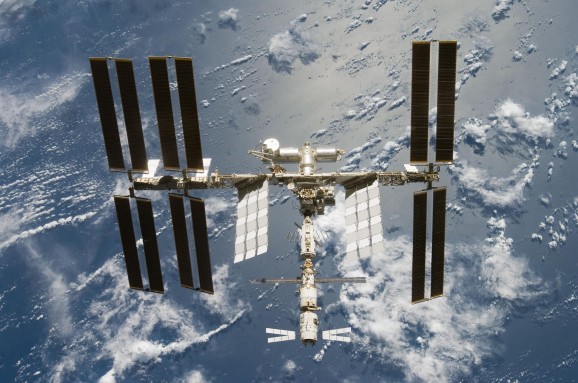ISS Gets A Four-Year Extension
This article is more than 2 years old
 I’m not sure if you knew that the International Space Station had a pre-planned death date. Maybe that’s being melodramatic. Let’s call it decommissioning and deorbiting. Whatever name you slap on it, the ISS’s final days were planned for 2020. While there are only a handful of people, robots, and private companies who will be directly affected when facility powers down, the significance and symbolism loom large. The ISS is a symbol of cosmic collaboration, as well as the first step of the realization of the dream that people will one day live and work in space. So let’s all celebrate because the station just received a four-year extension, and will be in service until 2024. If nothing else, that’s four more years of Chris Hadfield videos.
I’m not sure if you knew that the International Space Station had a pre-planned death date. Maybe that’s being melodramatic. Let’s call it decommissioning and deorbiting. Whatever name you slap on it, the ISS’s final days were planned for 2020. While there are only a handful of people, robots, and private companies who will be directly affected when facility powers down, the significance and symbolism loom large. The ISS is a symbol of cosmic collaboration, as well as the first step of the realization of the dream that people will one day live and work in space. So let’s all celebrate because the station just received a four-year extension, and will be in service until 2024. If nothing else, that’s four more years of Chris Hadfield videos.
The Obama administration announced the plan to keep the ISS running until 2024, although obviously the current President will be long out of office by then and whoever comes next could potentially reverse that decision. But the next Chief of Staff is unlikely to do so, and not because he or she is a fan of the station, not only because the ISS cost about $100 billion to make and has prompted over 100 rocket launches and spacewalks, but also because getting it down safely is an undertaking.
As some of you might remember from 2001, the Russians had to bring Mir down after 15 years of operation, which was three times longer than projected. The craft experienced structural and technical problems that made it unsafe for future missions, and at that point, the best option was to put the station out of its misery—after all, a controlled de-orbiting and destruction of the station is much preferred to an uncontrolled, unanticipated one. The Russians launched a ship to generate enough thrusting power to push the station into what’s called a “controlled descent,” which proceeds in stages. Most of Mir split and burned up in the atmosphere, and the remaining chunks fell into the South Pacific Ocean about 30 minutes after entering the atmosphere.
 The U.S. won’t want a repeat of the Skylab incident—in 1979 the 77-ton vehicle crashed to Earth unexpectedly, just one year after Russia’s Cosmos satellite crashed in Canada, littering radioactive debris over the western part of the country. Putting the ISS into a controlled de-orbit in just six years seems too soon, especially for the perpetually beleaguered NASA.
The U.S. won’t want a repeat of the Skylab incident—in 1979 the 77-ton vehicle crashed to Earth unexpectedly, just one year after Russia’s Cosmos satellite crashed in Canada, littering radioactive debris over the western part of the country. Putting the ISS into a controlled de-orbit in just six years seems too soon, especially for the perpetually beleaguered NASA.
Even though NASA spends $3 billion a year on the station, starting from scratch in terms of building a base of operations in space is a much costlier endeavor. It’s also important to keep the burgeoning industry of shuttling cargo to the ISS alive, especially now that it’s generated competition between companies, Orbital Sciences and SpaceX, with more on the way. The extension will also help with a labor force that’s been dwindling since the end of the Constellation program.
NASA officials say that the ISS could remain in perfect working condition until at least 2028, so perhaps its lifespan will be extended once more, especially if our international partners agree. But for now, the ISS has at least another decade in its future.












